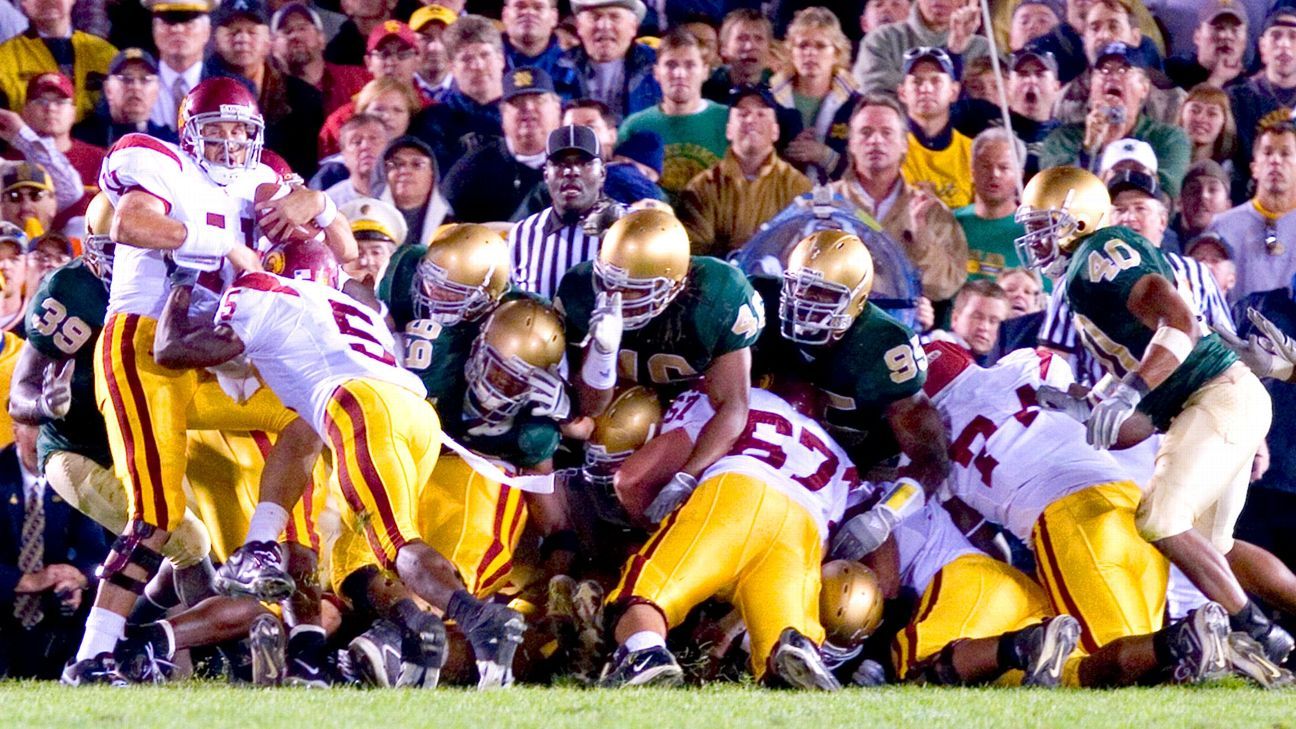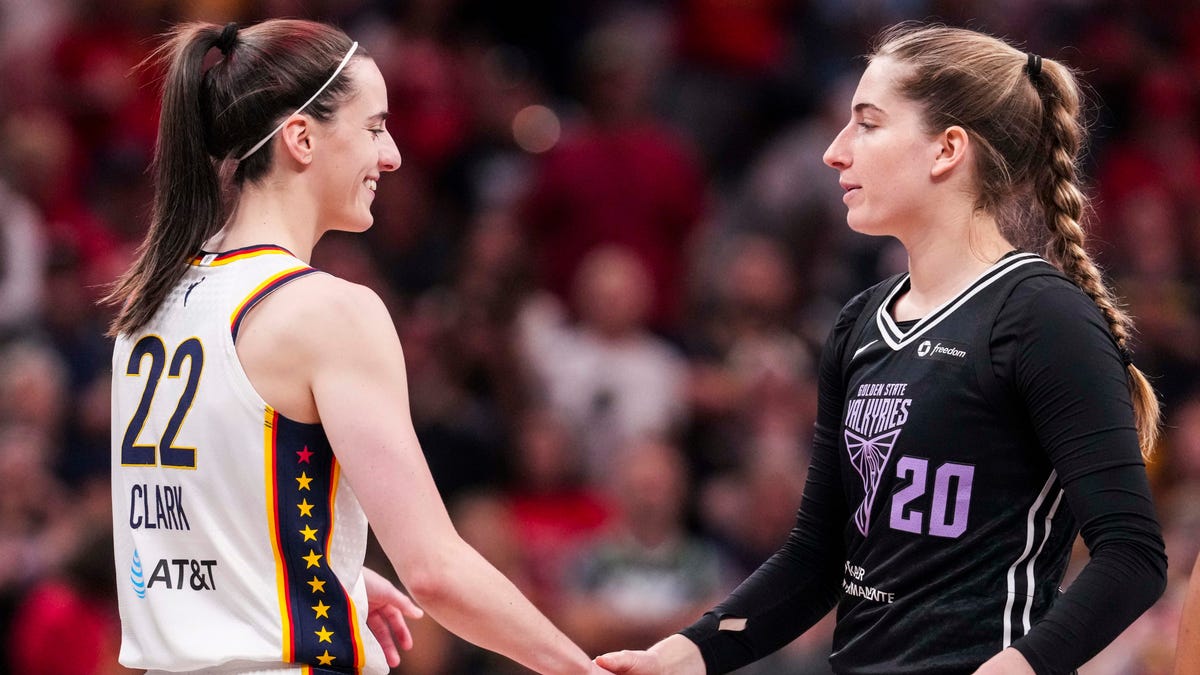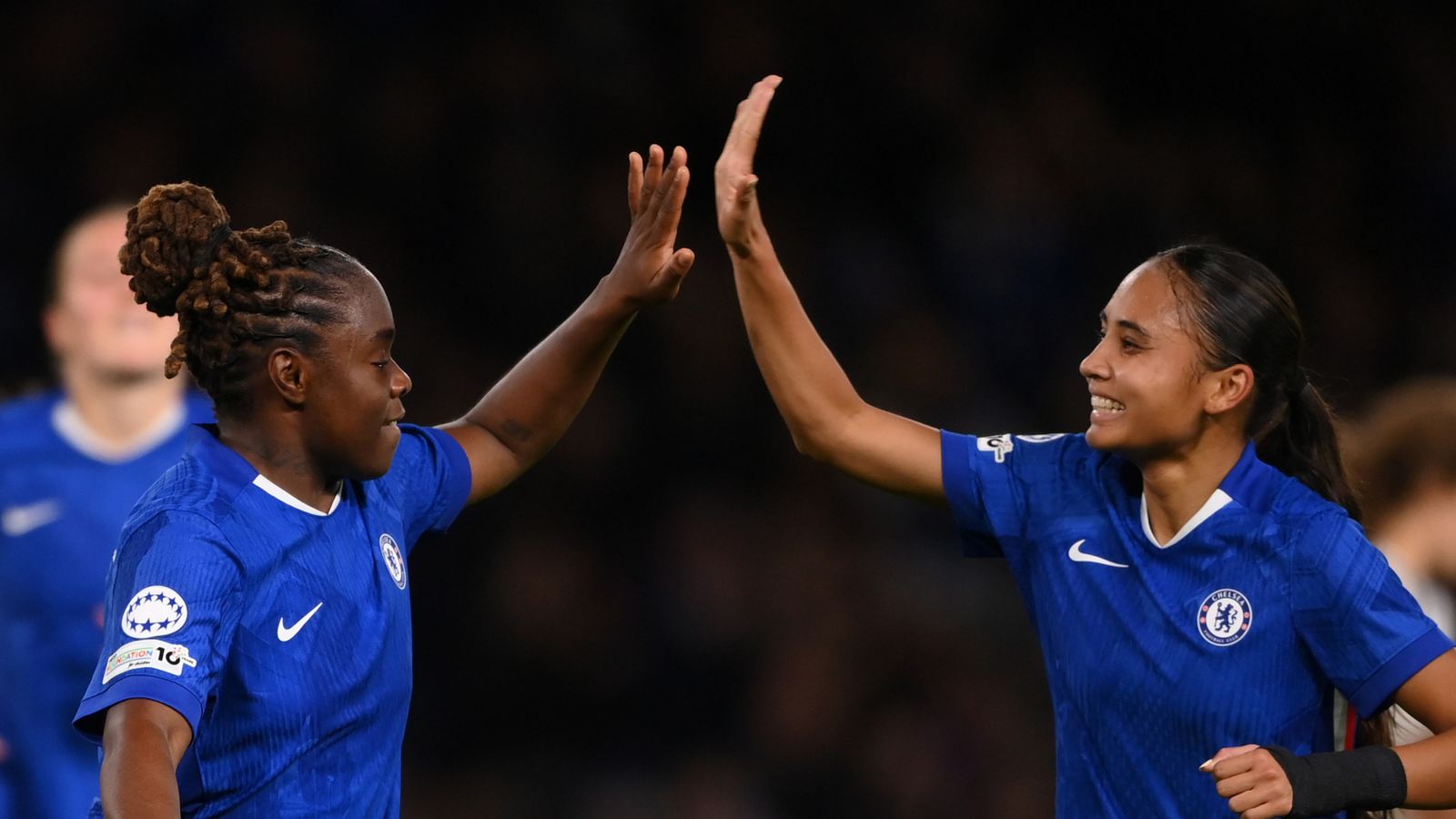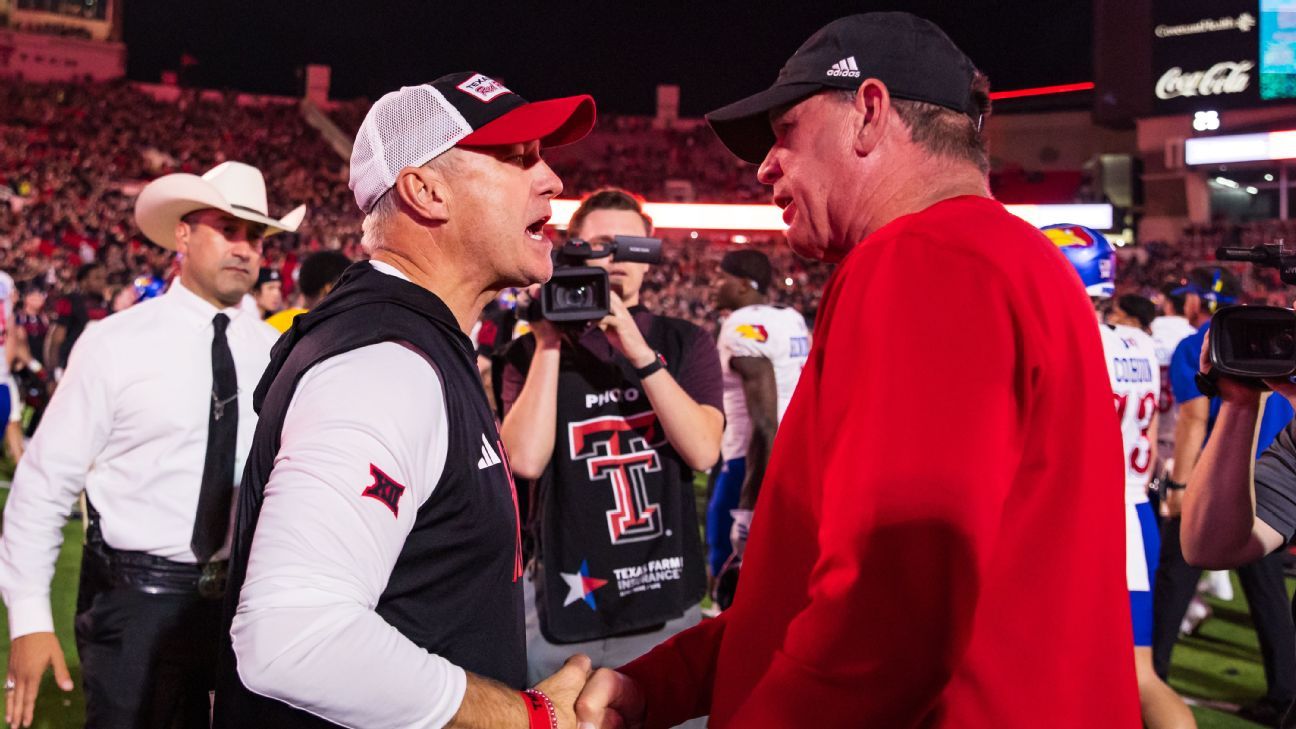
ON THE SIDELINE at Notre Dame Stadium, USC coach Pete Carroll frantically waved for quarterback Matt Leinart to spike the ball. The Trojans trailed 31-28, inches from the goal line with seven seconds left.
“[Leinart] was to look back at [offensive coordinator Steve Sarkisian] on the sidelines, and if we wanted to sneak it, we could sneak it,” Carroll said this week. “And he had to point at him. So, we tell him to sneak it. So, he points at the line, and he looks at the line of scrimmage, and he goes, ‘There’s no way, they’re all jammed up.’ And he looks back at us, and Reggie [Bush] yelled something at him, ‘Go for it. Go for it.'”
Moments earlier, Leinart had fumbled out of bounds inside the 1. The clock mistakenly ran out, and NBC’s Tom Hammond declared, “Notre Dame has won,” as Notre Dame coach Charlie Weis raised his arms and fans stormed the field.
When play resumed, the Trojans would have one last chance to extend their winning streak to 28 games.
Leinart sneaked left from under center, but he was bounced backward into a half spin and into the path of Bush, who famously shoved him across for the winning score.
“It was about as sweet a finish as you could have in a great situation to keep the streak alive and all that, too,” Carroll said.
Twenty years ago, the “Bush Push” would become one of the most unforgettable moments in college football history — and one of its most controversial. In the box score, it was the touchdown that preserved USC’s dynasty and allowed for the Rose Bowl matchup with Texas that became an all-time classic. In the rulebook, though, it was illegal.
Except, it was almost never called. In fact, the rule had become a running joke among officials.
“You were teased if you made the call,” said former NCAA official and current ESPN analyst Matt Austin. “It was such a rare occurrence.”
In the years that followed, an obscure rule became a flashpoint. It was debated, tweaked and, eventually, led to strategic evolution.
THE “HELPING THE Ball Carrier” rule had been part of the NCAA rulebook for decades. Its language was virtually identical in every edition dating back to at least 1950.
“No [teammate] shall grasp, pull, push, lift or charge into him to assist him in forward progress.”
The idea is believed to have originated as a way to differentiate football from rugby. Teammates could block defenders, but once the ball carrier was engaged, the play was meant to be his alone. Anything more — a shove, a tug, a lift — was considered an unfair advantage.
It was almost impossible to enforce in short-yardage piles, where pushes and blocks blur together, especially near the goal line.
Steve Shaw remembers that problem well. Now the NCAA’s national coordinator of officials, Shaw spent more than two decades on the field, and he has seen just about everything. But in the 2000 season, his crew made a rare, yet memorable call.
It happened during a Middle Tennessee-UConn game. Late in the contest, a Middle Tennessee lineman reached out and grabbed his running back, helping drag him toward the end zone. Shaw’s line judge, Mike Taylor, threw the flag.
“At the end of the year, there’s a report listing every penalty called nationally,” Shaw said. “Under aiding the runner, there was one — and it was ours. We gave him a hard time for calling it, but it was the right call.”
The rule technically existed, but almost nobody enforced it. And when it was flagged, it was usually because a player was being pulled, not pushed.
So when Bush shoved Leinart across the goal line in 2005, the officials did what most would have done: They kept the flag in their pockets. In fact, after Leinart’s touchdown, the Pac-10 officiating crew huddled up to discuss the play only to emerge with an unsportsmanlike contact penalty against the Trojans for their celebration after. There was no mention of the legality of the push on the broadcast, either.
It wasn’t until the next day when the conversation shifted from the game’s remarkable ending into a nationwide rules debate that is still built into the game’s lore.
Pac-10 commissioner Tom Hansen admitted to the Los Angeles Times that his conference’s officiating crew could have called a penalty, but made essentially the same point Shaw did two decades later.
“I just don’t think they ever call it,” Hansen said, adding it would have been different if it was a pull, not a push.
This is where the consensus seemed to land. The play looked like part of the normal chaos that happens at the goal line. By the letter of the law, Bush committed a foul. But by the spirit of the game, he just did what any teammate would do.
RULE CHANGES IN college football often move slowly. Proposals wind through the NCAA Rules Committee, a rotating group of coaches, officials and administrators who meet each offseason.
Most suggestions come after issues are identified over the course of a season. If the committee deems something urgent, it can move quickly. If not, it can linger in discussion until a consensus forms.
Sometimes, a single play can trigger an immediate rewrite. When Pitt quarterback Kenny Pickett faked a slide in the 2021 ACC championship game — beginning to give himself up before resuming his run for a long touchdown — the reaction was instant. Within days, the NCAA issued a memo closing the loophole. The same thing happened last year when Oregon’s Dan Lanning found a way to shave off game time by using a 12th man on defense.
The Bush Push didn’t work that way.
Despite the fierce public debate — and the way it was officiated — the rule remained unchanged in the years that followed.
It wasn’t until 2013, when the rules committee formally decided to adjust the official wording.
“The rules committee had a good debate about this and they watched much video, including the Bush Push play,” Shaw said. “Overall, they came to the conclusion that it was very difficult to determine when a push was truly a foul.
“There were few guidelines that could be given to make this a consistent call. Examples were pushing a rugby scrum pile vs. pushing the runner specifically, and they felt it was nearly impossible to distinguish between pushing a runner, leaning on a runner, pushing the pile or leaning on the pile. They felt removing the ‘push’ component would be the best course of action.”
When the NCAA released its updated rulebook for the 2013 season, the word “push” was simply deleted, bringing it in line with a similar rule change the NFL made in 2005.
Without realizing it, the committee paved the way for innovation in the sport.
Right away, coaches tried to use the subtle change to their advantage, including former Kansas State coach Bill Snyder, whose Wildcats started running what is now commonly referred to as the tush push later that year.
“It was just a natural thing to do,” Snyder told ESPN’s Kalyn Kahler earlier this year. “We needed to create a way in which we could take the shortest distance to get the short distance we needed to go and not get held up, because everybody put all the people over there, so we wanted to compete against no matter how many people you put there.
“We wanted to be strong enough not to get held up at the line of scrimmage. And we would bring one or two, or on occasion, three backs up right off of the hip of the center, and on the snap of the ball, we would push the center or push the back of the quarterback.”
That small tactical adjustment eventually made its way to the pros. Nearly a decade later, the Philadelphia Eagles adopted a version of the play built around quarterback Jalen Hurts, perfecting it into an almost unstoppable short-yardage weapon. Which, once again, led to a nationwide debate about whether pushing — once outlawed, then ignored and finally embraced — belonged in football at all.
In May, a proposal from the Green Bay Packers to ban the tush push came up two votes shy of the 24 it needed to pass.
At the NCAA level, the play drew some discussion over the offseason, too, but those conversations were more centered on potential injury concerns.
“The NCAA rules committee has looked at it and really up to now have not seen it become an injury, a player safety issue,” Shaw said. “So it really becomes a strategic part. Is that something strategically we want in the game? And so far there’s not been a big driver to try to put together a reason to eliminate it from our game.”
Over the past four seasons, the current rule has been enforced only six times, according to Shaw. Three times in 2022, and just once in 2021, 2023 and 2024.
AS USC RETURNS to Notre Dame this weekend for a top-20 matchup, the Bush Push helps define one of the sport’s most storied rivalries.
Carroll, now the Las Vegas Raiders coach, has very specific memories of that game in South Bend: the high grass, the green Notre Dame jerseys, the legends in the crowd.
“The stories I heard are that they sold out the night before the game at their rally that they had,” Carroll said. “And they brought Joe Montana back, and Rudy [Ruettiger] came back to speak to the crowd and a guy dressed up as Jesus showed up trying to bring home the power. … It was just an incredible setting for college football.”
The push that once went uncalled now defines the rule. Twenty years later, it’s still moving the game forward.
ESPN NFL reporter Ryan McFadden contributed to this story.
#legacy #legality #Bush #Push #years






